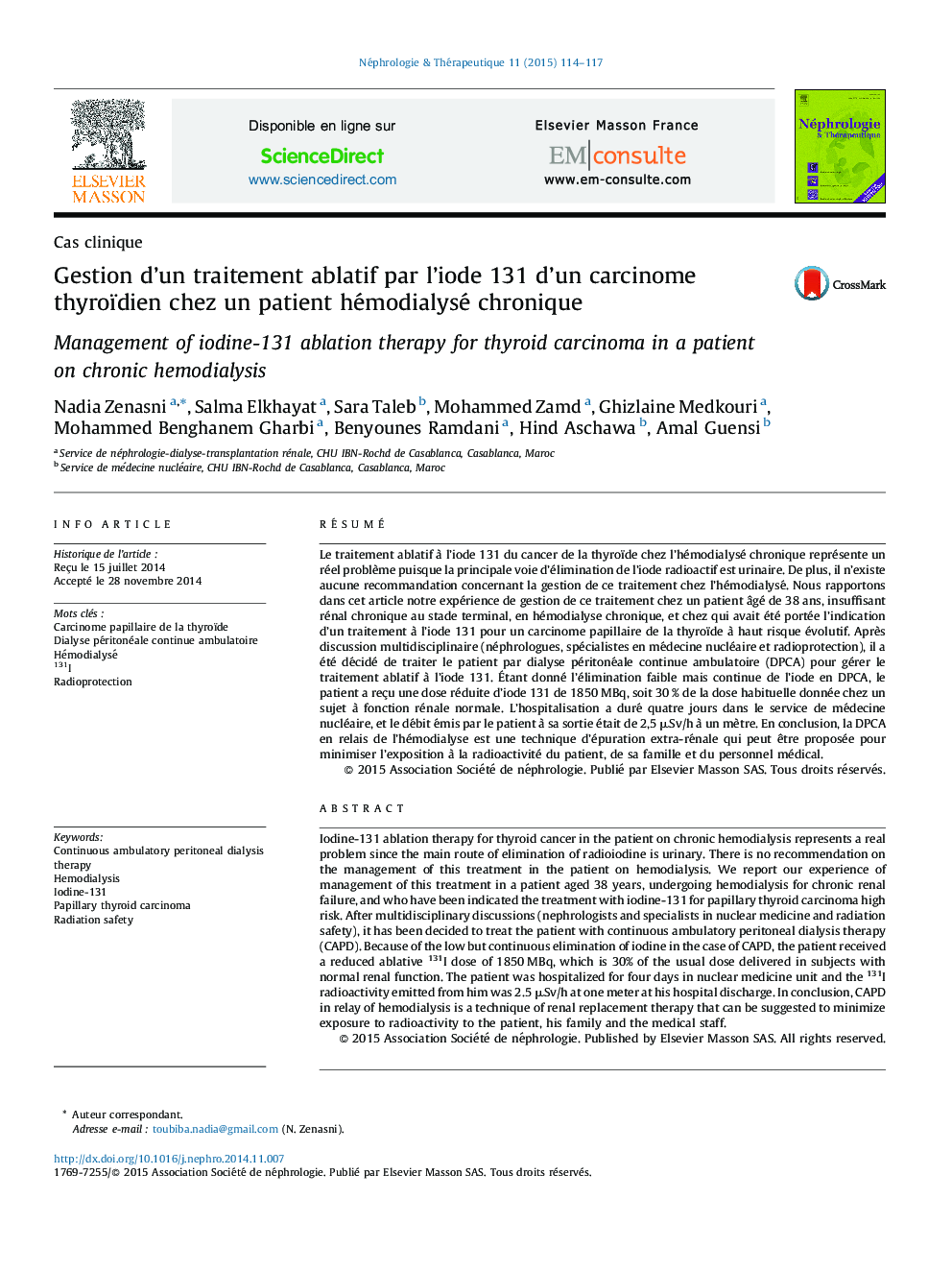| کد مقاله | کد نشریه | سال انتشار | مقاله انگلیسی | نسخه تمام متن |
|---|---|---|---|---|
| 3893958 | 1250107 | 2015 | 4 صفحه PDF | دانلود رایگان |

RésuméLe traitement ablatif à l’iode 131 du cancer de la thyroïde chez l’hémodialysé chronique représente un réel problème puisque la principale voie d’élimination de l’iode radioactif est urinaire. De plus, il n’existe aucune recommandation concernant la gestion de ce traitement chez l’hémodialysé. Nous rapportons dans cet article notre expérience de gestion de ce traitement chez un patient âgé de 38 ans, insuffisant rénal chronique au stade terminal, en hémodialyse chronique, et chez qui avait été portée l’indication d’un traitement à l’iode 131 pour un carcinome papillaire de la thyroïde à haut risque évolutif. Après discussion multidisciplinaire (néphrologues, spécialistes en médecine nucléaire et radioprotection), il a été décidé de traiter le patient par dialyse péritonéale continue ambulatoire (DPCA) pour gérer le traitement ablatif à l’iode 131. Étant donné l’élimination faible mais continue de l’iode en DPCA, le patient a reçu une dose réduite d’iode 131 de 1850 MBq, soit 30 % de la dose habituelle donnée chez un sujet à fonction rénale normale. L’hospitalisation a duré quatre jours dans le service de médecine nucléaire, et le débit émis par le patient à sa sortie était de 2,5 μSv/h à un mètre. En conclusion, la DPCA en relais de l’hémodialyse est une technique d’épuration extra-rénale qui peut être proposée pour minimiser l’exposition à la radioactivité du patient, de sa famille et du personnel médical.
Iodine-131 ablation therapy for thyroid cancer in the patient on chronic hemodialysis represents a real problem since the main route of elimination of radioiodine is urinary. There is no recommendation on the management of this treatment in the patient on hemodialysis. We report our experience of management of this treatment in a patient aged 38 years, undergoing hemodialysis for chronic renal failure, and who have been indicated the treatment with iodine-131 for papillary thyroid carcinoma high risk. After multidisciplinary discussions (nephrologists and specialists in nuclear medicine and radiation safety), it has been decided to treat the patient with continuous ambulatory peritoneal dialysis therapy (CAPD). Because of the low but continuous elimination of iodine in the case of CAPD, the patient received a reduced ablative 131I dose of 1850 MBq, which is 30% of the usual dose delivered in subjects with normal renal function. The patient was hospitalized for four days in nuclear medicine unit and the 131I radioactivity emitted from him was 2.5 μSv/h at one meter at his hospital discharge. In conclusion, CAPD in relay of hemodialysis is a technique of renal replacement therapy that can be suggested to minimize exposure to radioactivity to the patient, his family and the medical staff.
Journal: Néphrologie & Thérapeutique - Volume 11, Issue 2, April 2015, Pages 114–117